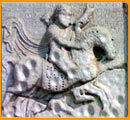|
|
|||||||||||||||||||||||||||||||
|
|
|||||||||||||||||||||||||||||||
|
|
Medieval Verona
First big town on the routes that from northern or eastern Europe bring to Rome, Verona was besieged and conquered many times by the barbarians who flocked in the Italian peninsula after the fall of the Roman Empire. Thanks to its strategic importance, it became an important fortified center under the ruling of Odoaker, Theodoric, who built his fortress on the hill of San Pietro, Alboin, Pipin. Even if sometimes well hidden, many are the signs of the old middle age Verona. The churches built along the old via Postumia (nowadays via Cavour) like the mysterious luoghi di culto sorti lungo l'antica via Postumia (oggi via Cavour) come il misterioso sacellumof the Saints Teuteria and Tosca, probably the oldest church in Veneto, whose origins dates back to the fith century. The church of St. Lorenzo, with its unusual towers, Saint Stephen built on an old Roman temple or San Giovanni in Valle, an old Arian church built in the Castrum Gotorum, the defensive area where the Goths dominators lived separated from the rest of the town.
Le collezioni di gioielli, suppellettili, armi longobarde conservate al Museo di Castelvecchio, assieme alle sculture romaniche, testimonianze della vita quotidiana e artistica dell'alto medioevo a Verona e nella sua provincia. The Capitolare Library, dates back to VI century one of the oldest still existing in the world. It remained for all the Middle Age one of the centers of cultural life, not only in Verona, but in the whole Europe. "An Ark of salvation during the centuries hard for men, harder for books." The Capitolare library can be visited previous booking. in addition to the beautiful codexes and incunabula, the famous riddle of Verona can be admired, one of earliest proof of written Italian language dating back to the nith or eith century. In the aftermath of the first millenium and the dramatic earthquake in 1117, Verona experienced an important recovery, not only in the society and the arts but also in its architecture, that made of Verona one o most importat ceter of Romanesque architecture, with important monuments like the St Zeno Abbey, an undisputed Romanesque masterpiece with his mysterious and archaic bronze portals, the Cathedral, with the design of the misterious Nicolò and the splendid sculptures by Brioloto.
Guided tours af Romanesque architecture and medieval itineraries can be follewed in the province of Verona also, like in St Severo and St Maria of Cisano, on the Lake Garda, San Floriano and San Giorgio in Valpolicella For any question or more detailed information on guided tours and didactic itineraries in Verona, please write to:
|
||||||||||||||||||||||||||||||








